Methodist Orphanage, Raleigh, N.C.
Flashback Friday this week revisits a postcard view of Raleigh’s former Methodist Orphanage. So, given that, then, let’s mix it up a bit and take a closer look at the message written on the back of this week’s card, rather than the building itself.
I.
Your cards received and appreciated. My father is the maker of “Hicks Capudine” the great Headache remedy. I saw an order from Ft. Wayne yesterday. If you will look about at the different stores and …
— Wm. S. Hicks
Apparently, William Hicks was an early 20th century postcard collector, or ‘deltiologist.’ In the case of this week’s card, he probably sent at least two to his fellow collector, as this one is numbered with the Roman numeral ‘I’, and the message is written as if continuing onto another page. The postcards were then mailed to the recipient in an envelope.
Amazingly, we have found two additional such postcards sent from William Hicks.
In the message on the example below William gives us a peek into the extent of his collection and the number of collectors he corresponds with.
I am in Exchange with 106 different persons at present. I have over 504 cards from these members. Have you Ex. with R.S. Foster — Bridgeport – Conn? He sends fine views, answers very promptly. Also Caul (?) Laumann, Ft. Wayne – Ind. I have 47 from the latter.
— Wm. S. Hicks
In this card depicting the William J. Andrews residence in Raleigh, William Hicks wrote a note about the image itself. We published this card last year on Flashback Friday.
This is not one of the finest residences we have, but is about the coolest. It is in the northern part of the city among gigantic oaks.
— WSH
William corresponded with 106 fellow collectors. We have three postcards that he sent them — I wonder how many more are out there?
William S. Hicks was born in 1895, the son of Henry T. and Ida Hicks. These cards date to the 1907-1914 period, so William was a teenager when he collected his 504 postcards. As he noted on this week’s card, his father was “the maker of ‘Hicks Capudine’ the great Headache remedy.”
Hicks’ Capudine — Miracle Drug or Snake Oil
Pharmacist Henry T. Hicks operated two drugstores on Fayetteville Street at the turn of the 20th century. Around 1900 Hicks had developed and patented Capudine, an all purpose headache cure and pain reliever.
The miracle drug was guaranteed to treat, as expressed in the language of the era, headaches, colds, la grippe (i.e. influenza), neuralgia, sick headaches, nervous headaches, acidity, flatuency, indigestion pains and dysmenorrhea (i.e. menstrual cramps). Hicks, a licensed pharmacist, assured his clients that his cure was not a “dope,” and was not habit forming.
This early 20th century drugstore serving tray advertised the “prompt results” guaranteed delivered by Hicks’ liquid Capudine.
By 1901 Hicks had introduced Hicks’ Huckleberry Compound, Dr. Nagles’ Prescription for Coughs and Colds, Castoline (a castor oil compound), and Dr. Nagles’ Kidney and Liver Pills. These miracle drugs were all manufactured at his Raleigh-based Capudine Chemical Co.
This neatly packaged 2-ounce bottle of Hicks’ Capudine Liquid cost thirty cents in 1920.Â
As a result of the nation-wide popularity of Hicks’ patent medicines, the good druggist soon found himself a very wealthy man. So wealthy, in fact, he was able to build this fabulous Neo-Classical “Colonial” mansion on Hillsboro Street in 1913.
Henry Hicks’ mansion still stands on Hillsboro Street, though, sadly, its grandiose porticoes have been long lost.Â
Interestingly, just as Hicks was achieving wealth and renown, the American Medical Association commenced a crackdown on patent cure-all medicines.
The Association analyzed Hicks’ Capudine and found the concoction to be “a brown, rather syrupy liquid, slightly alkaline to litmus, with an aromatic odor and a salty taste. Besides 8 percent alcohol, Capudine was found to contain sugar, aromatics, chlorides, caffeine, antipyrin and salicylates.” Yikes!
In a 1912 scathing report titled “Nostrums and Quackery: Articles on the Nostrum Evil and Quackery” the AMA declared that Hicks’ Capudine was “a barefaced attempt to exploit . . . both the medical profession and the public, [and that] this nostrum is probably preeminent in the annals of the ‘patent medicine’ business.”
Nonetheless, although Mr. Hicks died in 1940, the Capudine Chemical Co. continued to manufacture ‘medicinal cures’ in Raleigh into the early 1960s.
Our Flashback Friday ‘chromolithographic’  postcard this week was published by Paul C. Koeber Co. of New York.
Paul C. Koeber Co. (PCK) 1900-1923
85 Franklin Street. New York, NY and Kirchheim, GermanyPublished national view-cards and illustrations in chromolithography and in black and white. Much of their color work has a dark heavy feel to it because of the many thick layers of ink they used. In their later years they published postcards using tinted halftones.
“Flashback Friday†is a weekly feature of Goodnight, Raleigh! in which we showcase vintage postcards depicting our historic capital city. We hope you enjoy this week end treat!

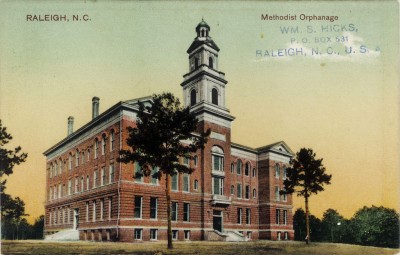
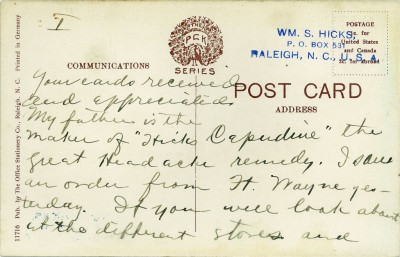
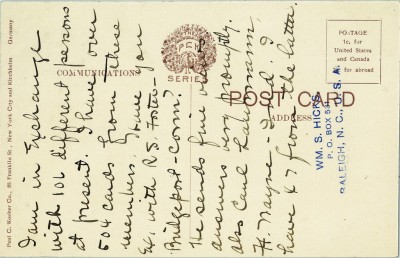
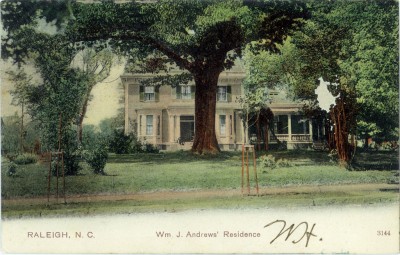
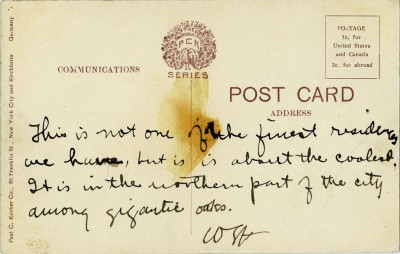
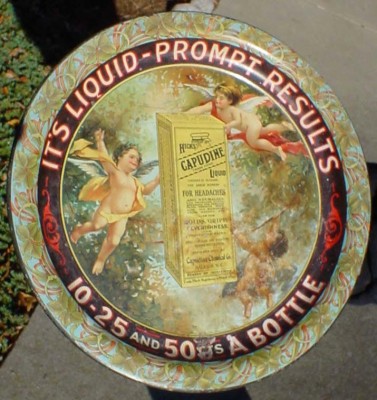
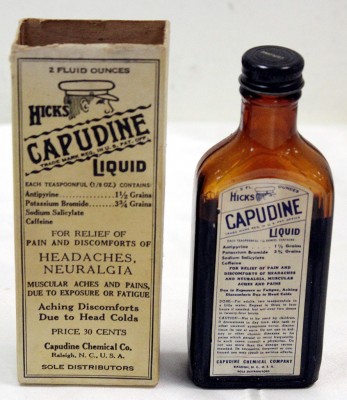
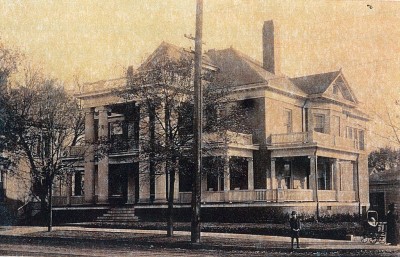

 Sign up for the Newsletter
Sign up for the Newsletter
06/06/2015
I have a 6 oz. brown bottle with the words Capudine for Headache in the glass, that I found in pisgah national forest next to my property in Asheville. I never knew it was the product of my hometown Raleigh!
06/24/2015
I have a 1 oz. brown Hicks Capudine bottle I dug from an old earth covered dump site around 1972. The dump was located on Fayetteville Rd. across the street from the E.B. Bain water treatment plant. I assumed the dump was an old Raleigh landfill that closed many years before. Now I know a little something about the bottle. Thanks.
05/18/2016
Hubby just walked in from the mailbox with a piece of brown glass with enough print to read Hicks and Cures All, we had to research and found this and other info on Hicks. Thanks for info, quite interesting especially since we live in Florida…love finding history in our front yard.